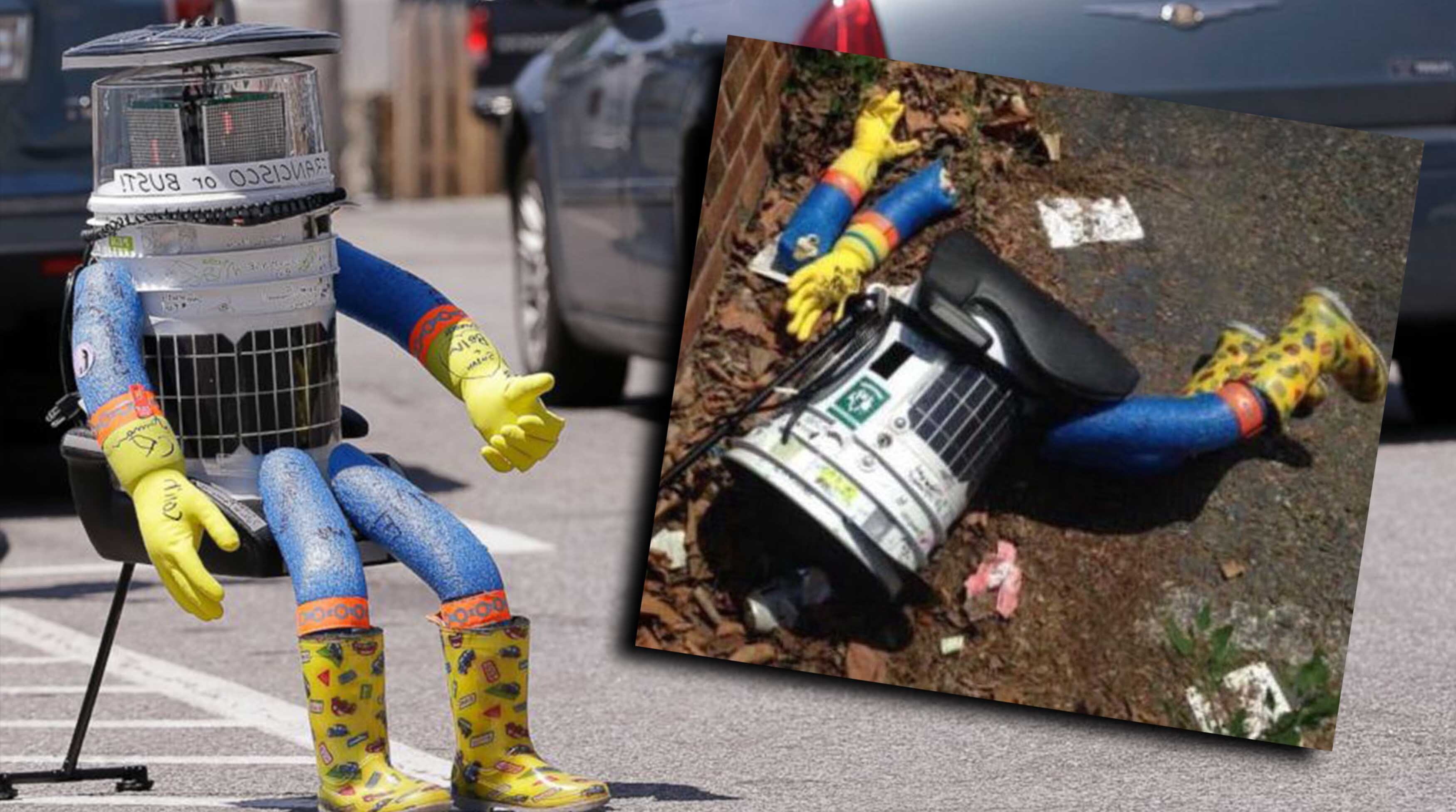The Life and Death of hitchBOT
Was it a social experiment gone wrong? Or did it produce results exactly as intended? In 2014, robotics and communications scholars developed hitchBOT, a hitchhiking robot. It made its way across Canada, Germany and The Netherlands, but couldn’t make it 2 weeks in the USA without being destroyed. In this episode, we tell the story about the life and death of the hitchhiking robot, then play the quick quiz with Comedian Glen Tickle.

Jack Kerouac wrote in his book On the Road “One of the biggest troubles of hitchhiking is having to talk to innumerable people, make them feel that they didn’t make a mistake picking you up.” Today’s story is about testing the faith in human kindness of those innumerable people.
Halifax, Nova Scotia to Victoria, British Columbia. It’s a route that crosses almost all of the Country of Canada, East to West. It’s an almost 8 hour flight, but by car it would take you 58 hours. A full week of driving. For the subject of our story, the goal was to make it that distance via hitchhiking and see how long it took.
HitchBOT was conceived by Dr. David Harris Smith of McMaster University and Dr. Frauke Zeller from the school of Professional Communication at Ryerson University. It was a collaborative effort that mixed sociology and robotics with a sort of performance art. Drs. Smith and Zeller said “usually we are concerned whether we can trust robots… but this project takes it the other way around and asks: can robots trust human beings?
The project began back in 2013. Drs. Smith and Zeller led a team of 13 robotics, communications and software students to develop a robot that would appear friendly enough for passers by to want to pick up and sustainable in order to make it the entire 2,800 miles.
So where did this bizarre idea come from? Smith says he was inspired by a few things – one of them being exploring the relationship between humans and objects and how we explore the symbiosis between them and derive the concept of agency. One of the things he has pointed to is a story about the 17th century French philosopher Descartes.
Descartes had a daughter, Francine born in 1635. At the age of 5, she contracted Scarlet Fever and died. To cope with his grief, Descartes used his knowledge in building realistic automaton robots to construct a lifelike replica of Francine. Francine Descartes went with him everywhere, even sleeping in a box next to his bed at night. He would wind her up and talk to her in the evenings, and on one journey by sea, his ship encountered bad weather. The crew of the ship had heard Descartes talking in his room at night and assumed that the whole thing was witchcraft, and that was bringing in the rough seas. Someone broke into his room, found the lifelike automaton and were horrified. They smashed the doll to pieces and threw pieces of Francine into the sea. Stricken with grief once again, Descartes died soon thereafter.
For Smith and Zeller, this was an early example of the interface between humans and robots – the clashing of ideas of agency, free will and sentience – fashioning life and animating the inanimate.
There was also the 2011 project called Orby. It was a sphere with a stop motion camera developed by Liss Platt that was an art project meant to capture footage of its journey down a river, documenting the animals, views and people it encountered along the way.
Smith and Zeller had created a small art critic robot out of a Roomba floor vacuum and it would arbitrarily judge the art and tweet about its opinion. But for Smith, he had an interesting history of hitchhiking that could combine with this cultural question of how humans interface with robots.
Dr. Smith was interested in studying questions about social responsibility and safety within culture. Hitchhiking was at its peak in the 1970s and that was a time when the crime rate was higher than it is today, despite how most people feel. Smith had hitchhiked across Canada 3 times in his life.
Dr. Zeller specifically studied some of the ethical questions that arise when we talk about humans interacting with robots and artificial intelligence. So this project was a natural result melding their two areas of study. When they started planning their project, some of the first concepts they started studying were ethical ones. Here’s Dr. Smith speaking about some of those questions:
They built the robot to meet their specifications. To meet the definition of a robot, a machine has to have at least one moving part, so in the case of HitchBOT, this was an articulated arm with a thumb that would move up and down via an Arduino circuit. They wanted to create the creature to be somewhat anthropomorphic but not so close to humans as Descartes’s lifelike doll, Francine. The result was an almost vacuum-cleaner-looking body with arms, legs and a face made up of an LCD display that could show a red smiley face. It could communicate with the face and speaker – and through its own social media presence on Twitter, Facebook and Instagram accounts. It also had the ability to listen and record interactions in its proximity. It had on-board GPS, a microphone, speakers, a camera and a processor – all provided by a tablet. It used clever script software to write dialogue that the bot would use.
One of the many commands of HitchBOT were that as the unit was placed into a car, it asked to be plugged into the cigarette lighter. This was how the project remained sustainable as it traveled across the country. But it’s still the kindness of strangers that hitchBOT relied upon to get picked up on the side of the road.
The robot was made to listen to and respond to basic conversation, answer questions, and provide interesting conversational facts.
HitchBOT was picked up by its first driver on July 27, 2014. It was picked up by Canadians from all walks of life – including first nations people, who called it “Iron Woman.” The hitchBOT made a name for itself through media reports both in Canada and the U.S. and at times, the scientists had to remotely disable the GPS on board the robot to prevent crowds from visiting the robot during temporary stops in peoples’ homes. It made the successful journey from Halifax to Victoria in just 25 days, arriving In Victoria, British Columbia on August 21st. It was an absolute success.
A second hitchBOT project was attempted in Germany the next year. It successfully hitchhiked through the country for 10 days, then for 3 weeks in the Netherlands. But would the project work in the U.S.?
HitchBOT had successfully crossed the entire country of Canada from East to West. It had crossed Germany and The Netherlands. It was time to try it in America. On July 17, 2015, it started in Boston, Massachusetts with the goal of hitchhiking all the way to San Francisco, California – just over 3,000 miles away. The robot would vocalize to people a “bucket list” of 16 things it wanted to see along the way. For instance, it wanted to participate in a “wave” at a sporting event, so someone took it to a Red Sox game. It wanted to visit Times Square, and it accomplished that too. These things were accomplished through nothing but kind hearted people who wanted to take part in this social experiment. Complete strangers who almost treated this machine as if it were a real life friend. It was exactly the type of thing that Dr. Zeller wanted to study.
But getting the crap kicked out of it on the streets of Philadelphia wasn’t on that list.
That’s right. Less than 2 weeks after leaving Boston, on August 1st, hitchBOT was torn apart and stripped for parts in Philly. It’s head was removed, arms torn off and smashed. Dr. Zeller said “We can see on all our data that the tablet and battery and everything shut off at the same time so it must have been when they vandalised the bot.” She said that some good samaritans had “sent us images and it’s really beyond repair. There’s not a single wire inside and all the things are broken.” hitchBOT’s head was never found.
A lot could be inferred from the fact that this robot made its way thousands of miles through three other countries, but immediately was torn apart and killed in Philadelphia. But Drs. Smith and Zeller don’t blame the city.
Part of the social experiment was to explore and display the relationship between humans and robots. And part of the truth about humans is that they are sometimes violent. If they’re violent to each other, why wouldn’t they be violent to an anthropomorphized robotic hitchhiker?
If you’d like to see hitchBOT now, or what are rebuilt remains of hitchBOT, it’s displayed in the Canada Science and Technology Museum in Ottawa. French artist Linda Blanchett wrote a slightly fictionalized account of the life and death of hitchBOT in her stage piece called “Killing Robots” and a new hitchBOT was created – hitchBOT 2.0 – to tour France and promote the play in 2019. But the plan was scrapped when the world was gripped by a global pandemic.
So what can stop the creeping of artificial intelligence and human-like robots into our lives? What can keep robots from taking over and becoming almost sentient? Well in that instance – a plague. But also – Philadelphia.

Review this podcast at https://podcasts.apple.com/us/podcast/the-internet-says-it-s-true/id1530853589
Bonus episodes and content available at http://Patreon.com/MichaelKent
For special discounts and links to our sponsors, visit http://theinternetsaysitstrue.com/deals
Use promo code “INTERNET” for 15% off skincare products at www.aldernewyork.com

